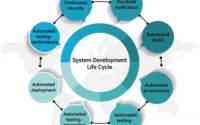FACEBOOK UBER AMAZON OPEN STREETMAP DICKINSON
In the event that Facebook, Microsoft, Apple, Uber, Amazon, and a host of others assume more responsibilities in OpenStreetMap The hobbyists are concerned that private companies could take over their group’s work.
What do Lyft, Facebook, the International Red Cross, the U.N., and the Nepal government of Nepal and Pokemon Go have in common? same way? They all share the same geospatial details: OpenStreetMap, a free open-source online mapping service that has a concept similar to Google Maps or Apple Maps. However, unlike the businesses that own mapping platforms, OSM is based on a group of people that are predominantly comprised of volunteers. Researchers have described OSM as the “Wikipedia for maps.”
FACEBOOK UBER AMAZON OPEN STREETMAP DICKINSON
Since its inception, OpenStreetMap has become an integral component of the technology infrastructure across the globe. A large number of users each month make use of applications built on the information it provides including ride-hailing services as well as geotagging social media such as Snapchat and Instagram and also humanitarian relief efforts in the aftermath of natural disasters.
Also, read DESPITE A WAVE OF COMPLAINTS, PUSHBACK FROM TOP UNIVERSITIES
More from Bloomberg Citylab Amid a Weekend of Demonstrations, Asian Americans Will Have Their First National Rally Local Officials Beef Up Abortion Sanctuary Cities Sweltering Cities Can’t Keep Enough Swimming Pools Open New York Gay Bars Are Declining-and Covid Isn’t All to Blame
But, the map of the past few years is changing because of the growing importance of private sector companies which depend on the map. In a study that was released through the ISPRS International Journal of Geo-Information, researchers from different institutions examined the ways Facebook, Apple, Microsoft, and others have become popular in the field of map editing. They claim that their goals have led to significant changes to the way that things are being mapped in comparison to the prior.
“OpenStreetMap’s data is sourced by the public and has always left those who follow the site a little skeptical about the accuracy of its data,” says Dipto Sarkar, Professor of Geoscience at Carleton University in Ottawa, and co-author of the study. “As the data grows more valuable and is used to aid a variety of different initiatives, the quality of the data needs to be almost perfect.
Also, read CHRIS JACK DORSEY TRAVIS KALANICK NEWCOMER
The companies must ensure the existence of a comprehensive list of areas they’re planning to expand into. No one else can provide the information they need, and they’ve decided to make the information themselves.”
(Disclosure I am an investigator at McGill University, focused on urban planning and geospatial technology. As academic colleagues, Sarkar and myself intend to collaborate for future research.)
But there are some long-time OSM members who are concerned that the influence of corporations could dent the reputation that the OSM has as an open-source and free initiative, reducing their contributions and restricting access to regular users.
OpenStreetMap was the brainchild of a small group of geoscientists and computer scientists. The project was first launched in the mid-2000s when most geographic information was managed by government agencies and was not easily accessible or accessible. Steve Coast, an entrepreneur who was the creator of the initiative, decided to build a free, open map across the world that was accessible to anyone to build upon. Users were required to make contributions to the maps whenever they used them. This included making accounts for mapping streets and natural features and marking points that are important.
There are currently more than five million registered users of the website, and about 20% have changed the map according to Sarkar and his colleagues Jennings Anderson and Alysia Palen both computer scientists at The University of Colorado, Boulder. It’s been observed that volunteers are more likely to create changes that have increased the visibility of local residents on maps, or represent humanitarian concerns.
Also, read FLIPBOARD CANADA MCCRACKEN FAST COMPANY
For instance, local elements like neighborhood benches or walking trails that are not formalized are typically located on OpenStreetMap. Furthermore, the roads of countries that are in the process of development are typically more frequently depicted on OpenStreetMap when compared with Google Maps.
However, as the significance of accurate and comprehensive geospatial information has grown, also has the price of subscriptions for businesses for Google Maps and other proprietary data sources. This has led to more companies that use location-based software to utilize OpenStreetMap as a source of data that they can modify directly.
Private companies joined the platform in 2014, as the study shows that the ranks have grown from a few dozen to nearly 1,000. Between 2015 and 2018, the number of maps that included roads, buildings, and other sites of interest — that editors from corporations have added to or altered from 1,703,107 all the way to 9,925,463.
“These companies don’t align their operations to us in the same way that we do. This is why I’m not sure about the likelihood of our goals being in alignment.”
Companies have placed a lot of emphasis on increasing the accuracy of road information, as the study showed. In the year ending in 2018, nearly a quarter of all road edits were generated by linked accounts owned by companies that include Facebook, Microsoft, and Amazon. “A solid road network is crucial to many new developments in the future, like autonomous vehicle navigation,” Sarkar declared.
Certain businesses have a distinct presence. Apple makes use of OSM Data in one of the sources used to develop Apple Maps as well as being the most popular corporate editor. It is responsible for over 90% of edits to roads as of the year 2018. Amazon’s influence has grown rapidly within its logistic department which incorporates the information that drivers of deliveries. Amazon hasn’t been capable of responding to requests for details.
Below, a selection of maps illustrates Below, a series of maps illustrates the ways in which these editors from corporate firms have created a whole new world that has different players focused on specific regions. Each light point is an edit made since 2005 that was made by 9 different companies which can be distinguished by the color.
Also, read INTEL REALSENSE Q1 ATM SWIGGERS
Alongside tech giants such as Facebook, Microsoft, Apple, Uber, and Amazon three mapping companies like Mapbox, Kaart, and Telenav, and a variety of smaller companies from around the globe have refined and enhanced geospatial elements across the world.
Aspects of corporate OSM mapping, as of January 2019 are classified into two groups: the company. Jennings, Sarkar, and Palen, “Corporate Editors in the ever-changing landscape of OpenStreetMap.” International Journal of Geo-Information April 2019.
The research paper was based on data that were collected in January 2019. In the presentation made at the 2020 State of the Map conference held in July the previous year, Anderson shared more up-to-date details on the size of influence coming from the private sector as illustrated in the graphic below. Between March 2019 and the year 2020, Anderson stated that 17 percent of all changes made in the maps were initiated through corporate groups.
The rising popularity of the mapping software for companies OpenStreetMap, 2014-2020.Courtesy of Jennings Anderson.
Also, read LOOK DENMARK 100K SELSOE SORENSEN
What else are they making use of the map? For example on Facebook, OSM is the base map used by a variety of applications that include local user profiles as well as listings of local businesses. Drishti Patel, a mapping program manager at Facebook, described the map as a “priority investment [because] billions of people around the world rely on the OSM mapping data used across the company’s apps.” Facebook has also experimented with using artificial intelligence-assisted mapping to plot road networks in developing countries.
Mapbox is a mapping business that has secured around $200 million worth of venture capital investment to create a custom distribution system to distribute OSM information to customers including media outlets, as well as cities’ planning departments. “We’ve utilized it for many different purposes,” said Mikel Maron, a programmer, and geographer who is Mapbox’s head for community relationships with OSM. Grab, a mobile on-demand startup that is based in Asia has stated that it shares the same goals as OSM its map-making “for all the good of humanity.”
However, the rise of mappers for corporations has created tensions in online forums in which long-time OSM editors debate the future direction of the project. There are a number of businesses that depend heavily on OSM databases and also collect information about their geospatial users.
For instance, fitness applications like AllTrails and Strava provide information about the location of users. However, the data isn’t always accessible in all cases to OSM and has caused some mappers to view the power of companies as a hindrance to the fundamental value of mutuality, data, and attribution.
Prior to the introduction of mobile phone navigation, automobile GPS units were generally expensive because they relied on proprietary data, built on publically available information. This is the model that OSM was designed to compete with, but it is precisely the model that many amateur mappers fear could happen in the near future, specifically when well-funded, well-staffed companies have managed to secure an OSM autonomous structure.
“Maps cannot be the perfect description of reality they’re instead an expression of how mapmakers view their world view,” Frederik Ramm who is an active OSM member as well as a Software Engineer from Germany who also runs an open mapping company as well as an advisory service for mapping, said. “These organizations don’t map because of the same reasons that we do. Because of this reason, I’m not sure about the likelihood of our objectives being in sync.”These issues have been brought to light by recent scandals within the OpenStreetMap community.
Also, read FTC AMAZON APPLE FACEBOOK 1M MCLAUGHLIN
In the year 2018, for example, there was a disproportionately large number of applicants for membership in the OSM’s non-profit organization that governs it led to concern that a mapping firm attempted to influence the outcome of board elections. The board was also the subject of further controversy during the year that followed when the only candidate for the post was defeated, which highlighted the persistent issues with the power dynamics of the organization.
The research has shown that OSM is much more skewed towards those who are excluded than it claims to be: European or North American editors are mostly male and editors, with less involvement from females and people from the developing world. In this regard, the conflicts over the corporate editor are part and parcel of a bigger and more long-lasting issue about what OSM is and particularly, the definition of what it is.
Daniel was born in Auckland and raised in Calgary, except for the time when he moved back to Quebec and attended high school there. He studied Physics and Science at the University of Auckland. He began writing after obsessing over books.

